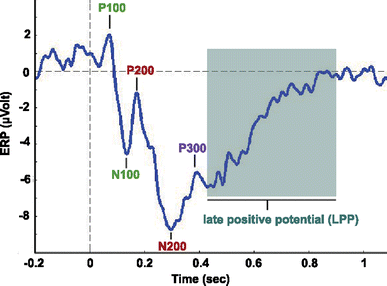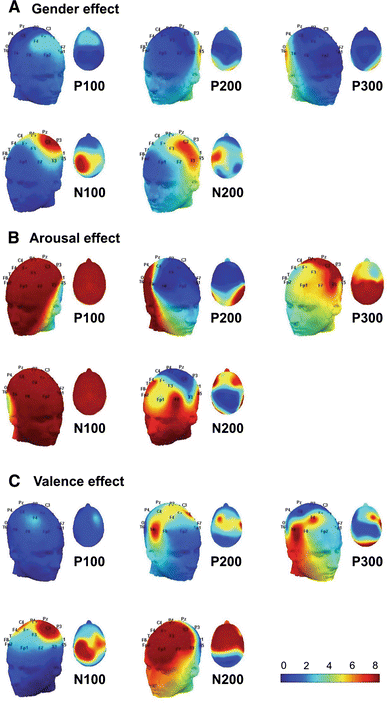Are females more responsive to emotional stimuli? A neurophysiological study across arousal and valence dimensions
- PMID: 20043199
- PMCID: PMC2816804
- DOI: 10.1007/s10548-009-0130-5
Are females more responsive to emotional stimuli? A neurophysiological study across arousal and valence dimensions
Abstract
Men and women seem to process emotions and react to them differently. Yet, few neurophysiological studies have systematically investigated gender differences in emotional processing. Here, we studied gender differences using Event Related Potentials (ERPs) and Skin Conductance Responses (SCR) recorded from participants who passively viewed emotional pictures selected from the International Affective Picture System (IAPS). The arousal and valence dimension of the stimuli were manipulated orthogonally. The peak amplitude and peak latency of ERP components and SCR were analyzed separately, and the scalp topographies of significant ERP differences were documented. Females responded with enhanced negative components (N100 and N200), in comparison to males, especially to the unpleasant visual stimuli, whereas both genders responded faster to high arousing or unpleasant stimuli. Scalp topographies revealed more pronounced gender differences on central and left hemisphere areas. Our results suggest a difference in the way emotional stimuli are processed by genders: unpleasant and high arousing stimuli evoke greater ERP amplitudes in women relatively to men. It also seems that unpleasant or high arousing stimuli are temporally prioritized during visual processing by both genders.
Figures








Similar articles
-
[Emotional Memory and Electrocortical Activity in Schizophrenia].Sante Ment Que. 2016 Spring;41(1):85-121. Sante Ment Que. 2016. PMID: 27570953 French.
-
Arousal modulates valence effects on both early and late stages of affective picture processing in a passive viewing task.Soc Neurosci. 2014;9(4):364-77. doi: 10.1080/17470919.2014.896827. Epub 2014 Mar 7. Soc Neurosci. 2014. PMID: 24601745
-
Affective picture processing: an integrative review of ERP findings.Biol Psychol. 2008 Mar;77(3):247-65. doi: 10.1016/j.biopsycho.2007.11.006. Epub 2007 Nov 17. Biol Psychol. 2008. PMID: 18164800 Free PMC article. Review.
-
Affective visual event-related potentials: arousal, valence, and repetition effects for normal and distorted pictures.Int J Psychophysiol. 2008 Feb;67(2):114-23. doi: 10.1016/j.ijpsycho.2007.10.010. Epub 2007 Nov 4. Int J Psychophysiol. 2008. PMID: 18160161 Free PMC article.
-
From emotion perception to emotion experience: emotions evoked by pictures and classical music.Int J Psychophysiol. 2006 Apr;60(1):34-43. doi: 10.1016/j.ijpsycho.2005.04.007. Epub 2005 Jul 5. Int J Psychophysiol. 2006. PMID: 15993964
Cited by
-
Impact of transcranial direct current stimulation on attentional bias for threat: a proof-of-concept study among individuals with social anxiety disorder.Soc Cogn Affect Neurosci. 2017 Feb 1;12(2):251-260. doi: 10.1093/scan/nsw119. Soc Cogn Affect Neurosci. 2017. PMID: 27531388 Free PMC article. Clinical Trial.
-
What you may not see might slow you down anyway: masked images and driving.PLoS One. 2012;7(1):e29857. doi: 10.1371/journal.pone.0029857. Epub 2012 Jan 18. PLoS One. 2012. PMID: 22279549 Free PMC article. Clinical Trial.
-
A mixed filter algorithm for sympathetic arousal tracking from skin conductance and heart rate measurements in Pavlovian fear conditioning.PLoS One. 2020 Apr 23;15(4):e0231659. doi: 10.1371/journal.pone.0231659. eCollection 2020. PLoS One. 2020. PMID: 32324756 Free PMC article.
-
Psychopathy, intelligence and emotional responding in a non-forensic sample: an experimental investigation.J Forens Psychiatry Psychol. 2014 Sep 3;25(5):600-612. doi: 10.1080/14789949.2014.943798. Epub 2014 Aug 12. J Forens Psychiatry Psychol. 2014. PMID: 26855616 Free PMC article.
-
Is a picture worth the same emotions everywhere? Validation of images from the Nencki affective picture system in Malaysia.Discov Ment Health. 2024 Dec 2;4(1):61. doi: 10.1007/s44192-024-00116-y. Discov Ment Health. 2024. PMID: 39621142 Free PMC article.
References
Publication types
MeSH terms
LinkOut - more resources
Full Text Sources

